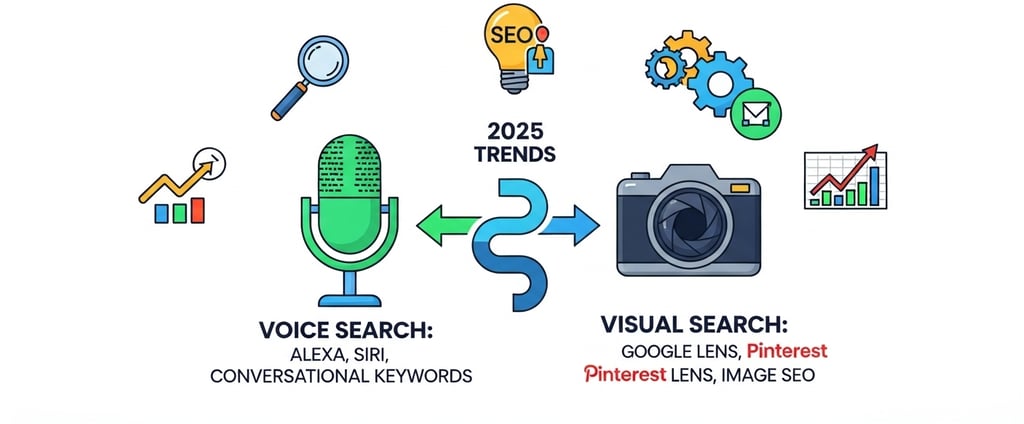A Comprehensive Guide to Optimizing Websites for Voice and Visual Search
10/11/20254 min read


Understanding Voice and Visual Search
Voice search refers to the technology that allows users to search the internet by speaking their queries aloud instead of typing them. It employs natural language processing and artificial intelligence to interpret spoken language, converting voice commands into text and delivering relevant results. Popular devices supporting voice search include smartphones, smart speakers, and home assistants such as Amazon Alexa and Google Assistant. According to recent statistics, almost 55% of households are expected to own smart speakers by 2025, indicating the growing adoption of this technology.
Visual search, on the other hand, enables users to search using images instead of text. This method allows users to take a photo or upload an image to find similar items online. Visual search technology leverages machine learning and computer vision, allowing platforms like Google Lens and Pinterest Lens to identify objects and provide relevant results. Recent studies highlight that approximately 62% of millennials prefer visual search over text, demonstrating a significant shift towards image-based queries.
The rising popularity of voice and visual search brings notable implications for businesses and content creators. With an increasing number of users turning to these methods, optimizing content to cater to voice and visual search is crucial. Businesses need to consider how their target audience formulates queries through spoken language or images, which may differ significantly from traditional text-based searches. By adapting their SEO strategies to account for these changes, companies can enhance their visibility and relevance in an evolving digital landscape. As consumers continue to engage with voice and visual technologies, the need for businesses to prioritize optimization strategies becomes ever more pressing.
Step-by-Step Tutorial for Voice Search Optimization
In recent years, voice search has gained significant traction, leading businesses to prioritize optimization for this technology. To effectively optimize web content for voice search, it is essential to follow a structured approach. The first step involves identifying conversational keywords that reflect the way users naturally speak. To achieve this, consider conducting keyword research focused on long-tail phrases and questions that potential users may articulate verbally.
Once you have identified these keywords, the next step involves structuring your content in a manner that effectively answers common spoken queries. This can be accomplished by organizing your content into clear, concise sections that directly respond to specific questions. Utilizing headings and bullet points enhances readability, making it easier for search engines to understand the context and relevance of your information.
A critical aspect of voice search optimization is the use of natural language. This means writing in a conversational tone that mimics everyday dialogues. When creating content, it is beneficial to incorporate phrases that are likely to be spoken rather than typed. This not only improves the chances of your content being surfaced in voice search results but also enhances the overall user experience.
Additionally, making your content accessible and engaging for voice-activated AI requires the incorporation of schema markup. This structured data helps search engines better interpret the information on your site, making it more likely to be featured in voice search results. For instance, implementing FAQ schema can clarify your site's relevance to common questions.
Examples of successful optimization practices include companies that have seen increased traffic by focusing on local SEO for voice searches. By integrating these techniques, your website can become a more viable resource for those utilizing voice search. Following these steps will position your content favorably in the evolving landscape of voice-activated searches.
Step-by-Step Tutorial for Visual Search Optimization
Visual search optimization is a critical component of modern SEO strategies, particularly as users increasingly rely on images for queries. To effectively optimize images for visual search, it is essential to follow best practices that ensure visibility and engagement. The first step is to select high-quality images that are relevant to the content. High-resolution images tend to perform better in search results and are more likely to engage users. Additionally, it is vital to choose images that accurately depict the subject matter, enhancing the overall user experience.
Once images are selected, the next step is optimizing the alt tags. Alt tags serve as descriptive text for images and are crucial for both search engine optimization and accessibility. When crafting alt tags, include relevant keywords, but be careful not to overstuff them. It is advisable to keep descriptions concise and focused on the image content. For instance, instead of a generic term like “image,” a more descriptive alt tag might be “red apple on a wooden table.” This practice not only improves visual search visibility but also aids visually impaired users in understanding the content.
Incorporating schema markup is another effective technique for enhancing image visibility in search results. Schema markup provides search engines with additional context about the images, which can improve the chances of appearing in rich snippets or image results. Utilizing structured data effectively ensures that search engines can interpret the content correctly.
Moreover, site speed plays a significant role in visual search efficiency. Images that are not optimized can hinder loading times, negatively impacting user experience and search rankings. Compressing images without sacrificing quality is essential. Finally, leveraging free tools like Google PageSpeed Insights and TinyPNG can help identify optimization opportunities, enabling quicker loading times and better visual search performance.
Common Mistakes and Testing Your Optimizations
Optimizing websites for voice and visual search comes with its own set of challenges, and several common mistakes can hinder success in these areas. One of the primary pitfalls is misunderstanding the nature of keyword usage. In the realm of voice search, users typically phrase their inquiries in a more conversational manner. This deviation from traditional keyword usage can lead to ineffective optimization if website content does not align with the natural speech patterns of users. Failing to incorporate long-tail keywords and question-based phrases can dramatically reduce visibility in voice search results, making it critical to tailor content specifically for these formats.
Another frequent error revolves around image handling. Visual search relies heavily on images, requiring websites to appropriately optimize these elements for search engines. Neglecting proper alt text, captions, and image descriptions can lead to missed opportunities in being discovered through visual search. It is essential to provide descriptive and contextually relevant information to assist search engines in understanding image content, ultimately improving visibility in visual search results.
To ensure that optimizations are effective, testing and measuring their success is vital. Utilizing tools such as Google Analytics or dedicated voice search optimization platforms can facilitate a comprehensive evaluation of performance. Monitoring metrics such as organic traffic from voice search, conversion rates, and engagement levels provides valuable insights into the effectiveness of the optimization strategies implemented. Additionally, A/B testing different approaches can yield data-driven conclusions, helping refine tactics over time. By continuously analyzing performance and making iterative adjustments, businesses can enhance their voice and visual search presence, ensuring ongoing success in a rapidly evolving digital landscape.
Connect
Stay updated with our latest tutorials.
Follow
Subscribe
© 2025. All rights reserved.
